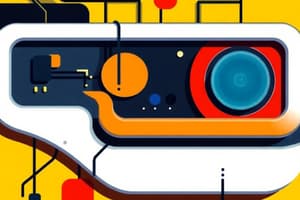Podcast
Questions and Answers
What is industrial design primarily concerned with?
What is industrial design primarily concerned with?
- Developing new technologies for manufacturing
- Designing products, services, and experiences to meet user needs (correct)
- Creating innovative solutions for businesses
- Evaluating the environmental impact of products
Which of the following is NOT a key principle of industrial design?
Which of the following is NOT a key principle of industrial design?
- Aesthetics
- Functionality
- Sustainability
- Marketing (correct)
What is the first step in the industrial design process?
What is the first step in the industrial design process?
- Testing and Refining
- Research (correct)
- Design Development
- Concept Development
What type of industrial design focuses on intangible experiences?
What type of industrial design focuses on intangible experiences?
Which famous industrial designer is known for his minimalist and functional design approach?
Which famous industrial designer is known for his minimalist and functional design approach?
What is the primary focus of usability in industrial design?
What is the primary focus of usability in industrial design?
What is the goal of the testing and refining stage in the industrial design process?
What is the goal of the testing and refining stage in the industrial design process?
Which type of industrial design focuses on designing interactions between humans and products?
Which type of industrial design focuses on designing interactions between humans and products?
Flashcards are hidden until you start studying
Study Notes
What is Industrial Design?
- Industrial design is the process of creating and improving the design of products, services, and experiences.
- It involves a combination of art, science, and technology to create innovative solutions that meet the needs of users and businesses.
Key Principles of Industrial Design:
- Aesthetics: The visual appeal of a product, including its shape, color, and texture.
- Functionality: The product's ability to perform its intended purpose.
- Usability: The ease of use and accessibility of a product.
- Sustainability: The environmental and social impact of a product throughout its lifecycle.
- Ergonomics: The design of products to fit human needs and capabilities.
Industrial Design Process:
- Research: Gathering data and insights about users, markets, and technology.
- Concept Development: Generating and refining ideas for products or services.
- Design Development: Creating prototypes and testing their feasibility.
- Testing and Refining: Iterating and improving the design based on user feedback and testing results.
- Production and Launch: Manufacturing and releasing the final product to the market.
Types of Industrial Design:
- Product Design: Designing tangible products, such as furniture, electronics, and appliances.
- Service Design: Designing intangible experiences, such as services and interactions.
- Experience Design: Designing holistic experiences, including products, services, and environments.
- Interaction Design: Designing interactions between humans and products, systems, and services.
Famous Industrial Designers:
- Dieter Rams: Known for his minimalist and functional design approach at Braun.
- Jonathan Ive: Credited with designing Apple's innovative products, such as the iPhone and MacBook.
- Eliot Noyes: Designed iconic products for IBM, including the IBM Selectric typewriter.
- Charles and Ray Eames: Pioneers in modern design, known for their contributions to furniture, architecture, and film.
Industrial Design Overview
- Industrial design combines art, science, and technology to create innovative solutions that meet user and business needs.
Key Principles of Industrial Design
- Aesthetics: concerns the visual appeal of a product, including shape, color, and texture.
- Functionality: refers to a product's ability to perform its intended purpose.
- Usability: involves the ease of use and accessibility of a product.
- Sustainability: considers the environmental and social impact of a product throughout its lifecycle.
- Ergonomics: involves designing products to fit human needs and capabilities.
Industrial Design Process
- Research: gathering data and insights about users, markets, and technology.
- Concept Development: generating and refining ideas for products or services.
- Design Development: creating prototypes and testing their feasibility.
- Testing and Refining: iterating and improving the design based on user feedback and testing results.
- Production and Launch: manufacturing and releasing the final product to the market.
Types of Industrial Design
- Product Design: designing tangible products, such as furniture, electronics, and appliances.
- Service Design: designing intangible experiences, such as services and interactions.
- Experience Design: designing holistic experiences, including products, services, and environments.
- Interaction Design: designing interactions between humans and products, systems, and services.
Famous Industrial Designers
- Dieter Rams: known for his minimalist and functional design approach at Braun.
- Jonathan Ive: credited with designing Apple's innovative products, such as the iPhone and MacBook.
- Eliot Noyes: designed iconic products for IBM, including the IBM Selectric typewriter.
- Charles and Ray Eames: pioneers in modern design, known for their contributions to furniture, architecture, and film.
Studying That Suits You
Use AI to generate personalized quizzes and flashcards to suit your learning preferences.




